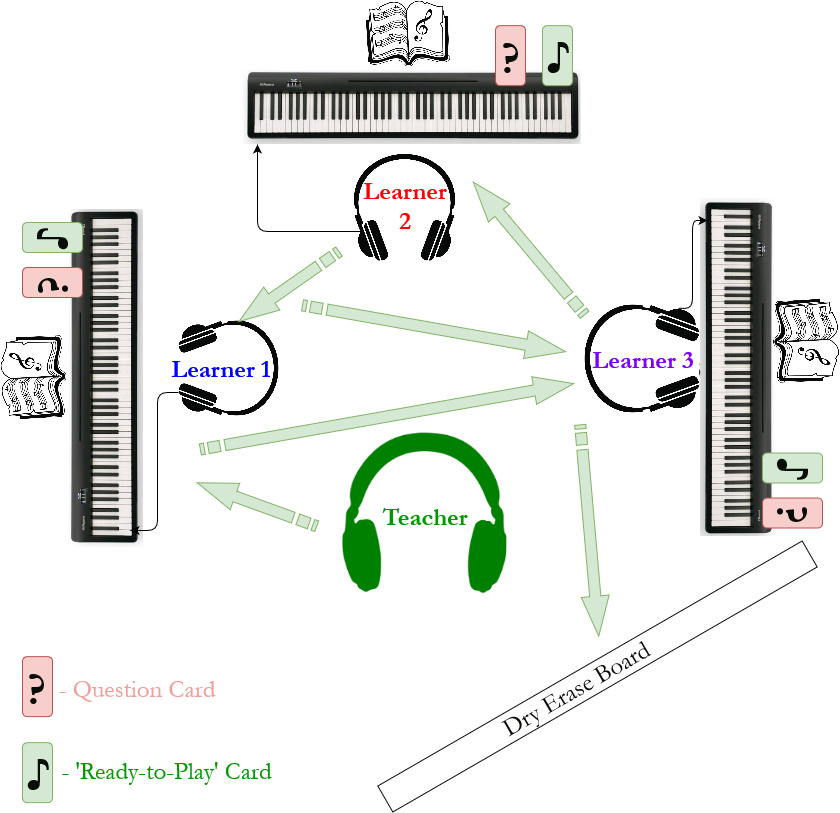Having completed much of the mental leg-work and preparation for the group program, I finally had an opportunity to see it in action! With help from three of my friends – Sam, Alex & Sylvie – I did a live pilot of the piano program. The three learners & I met for 1 hour at a time over a two-week period to see how they were able to learn in this context.

Some footage of the pilot learning environment.
Overwhelmingly, it was a success! I thoroughly enjoyed teaching in this social environment & was always on my toes. The students really enjoyed it as well (as evidenced by their unanimous desire to continue with the program). After we completed our second session, the participants participated in a discussion and debriefing with me. Below, I’ll share some of the strengths and areas for improvement that were revealed in the pilot.
Program strengths:
- Social – over the two sessions, the participants seemed to bond & get to know one another. They felt comfortable sharing their experiences, discussing challenges and celebrating the group’s successes. Moving forward, I’ll continue to find moments for sharing at the beginning, middle and end of the sessions. For instance, learners shared some of their favourite piano music with the group which was assigned as ‘listening homework’ to broaden everyone’s horizons.
- Productive – as I hoped, the sessions were highly productive for the students. The individual time to work fostered focus. During circulation, I was able to correct errors and draw attention to aspects like technique, articulation and rhythm. Overall, the students were learning at a rapid rate, having passed through ~30 pages of the Faber Primer book & Adult Beginner Course in only 2 hours. Sight-reading of notes & rhythms was as good or better than what I see at this point in 1:1 students.
- Challenging – learners reported feeling lots of self-efficacy. I was particularly happy to hear from them about their experiences with performance anxiety! They agreed that working solo was great for learning and polishing. In all the learners, however, they felt the familiar tense sensation of performance anxiety whenever I plugged into their keyboards and began to listen. I see this as a huge benefit – getting exposed to performance anxiety in bite-sized pieces. If I manage to frame these encounters with lots of positive reinforcement, balancing any tips with genuine praise for their progress, I believe we can extinguish or lessen the nerves they feel playing for others. This will make it easier for them to eventually perform their work publicly.
- Encouraging – the learners also noted that they enjoyed having other beginners around. They could overhear little tips and comments I made to others and be reminded to integrate these practices into their own play. It also made them feel good to hear that others were having trouble with note recognition, rhythm reading and finger independence (issues that plague every musician).
- Affordable – The director of the studio has agreed to charge only 50% of the typical rate for hour lessons in the group format. This is great for the learners.
Areas for Improvement:
- Integrating Adequate Theory Practice – the group lessons are designed to ‘first teach the hands, then the head.’ I would prefer that students learn to play before being inundated with cumbersome and discouraging theory. That being said, I would like to find a way to dovetail this work with appropriate theory exercises, perhaps from the Faber series.
- Tightening Up Explanations – when you have so many learners to inspire and guide in only an hour, it demands that really tighten up your explanations. Instead of having minutes to describe the function of a dotted rhythm, you may have only 30 seconds. I think this is a challenge that will really promote my growth as a musician and teacher by forcing me to truly comprehend the core of a concept in order to explain it effectively and efficiently.
- Mixed-Experience Groups – while this pilot cohort are all beginners starting at the exact same level, it is conceivable that I will have groups in the future. I want to strongly consider how to have groups of mixed ability levels moving forward but still keep the communication, discussion and ensemble performance features.
- Rewards System for Young Learners – my years tutoring at Sylvan taught me the potential value of token economies for promoting good habits in students. I envision, especially for <13 learners, implementing a system where students earn ‘quarter notes’ for meritorious behaviour (asking good questions, attention to detail, encouraging groupmates, etc.)
- Use of Technology – could music-education games like Ningenius and StaffWars be used throughout the lesson to diversify the experience of the learners?
Anyways, overall, I am pleased with how the pilot went. Since my pilot group is going to continue with their lessons, I’ll get lots more opportunity to hone this and consider how this program qualitatively differs from my 1:1 pedagogy.
-S


